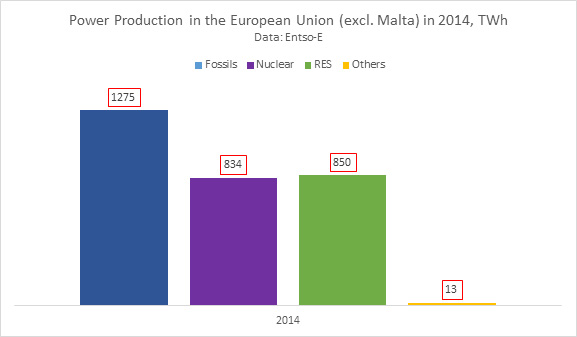Solar: a driver for the transformation of the power sector in Japanese
When looking at solar PV, observers usually highlight the massive technology cost decrease achieved over the past years. This evolution is firstly founded on the forward-looking demand-push policies started in Europe in the late 90’s, which led to an impressive market deployment - we have jumped from 129 MW of connected capacity in 2000 to almost 90,000 MW fifteen years later.
Combined with a strong development of wind, 2014 marked a tipping-point: for the first time ever in Europe, renewables produced more power than nuclear (see figure below). Solar is now covering 3.5% of the EU electricity demand, which is more or less the market share of a big utility in Europe.

But besides driving this ‘obvious’ change in the market distribution, solar also features two peculiarities which passed rather unnoticed and may actually have a more profound effect on the transformation of the power sector. The first one is the particular ‘accessibility’ to the solar value chain. Unlike coal, gas or nuclear which usually require decades of experience and an international presence, new entrants can much more easily step into the solar business. Solar is not about extracting finite resources and transporting them via large-scale and costly infrastructures; it ‘simply’ is a manufacturing industry transforming sun into electricity, with all the characteristics of a mass product production process. This is rather good news: it indicates that the industrial transformation and the transfer of jobs associated with a successful energy transition can happen.
The second peculiarity of solar is maybe even more important for the future make-up of the energy landscape: solar perfectly matches with the mega-trend observed today in Europe, namely the shift towards a ‘close to the end-consumer’ value creation. In order to succeed – or remain successful – in the emerging decentralised energy world, incumbent players will have to change their perception of solar. Rather than a pure competitor to traditional energy sources, solar is their new gateway to the final consumer. By offering new complementary solutions to the prosumer (financing, storage, aggregation, etc) innovative players will grow their business by making sure consumers will be able to better control their energy costs.
Now that Japan is at a crossroads in terms of energy policy, these trends on the European front can be useful food for thought. Solar is more than a local, renewable energy source; it is part of the solution in a more comprehensive industrial transformation.

